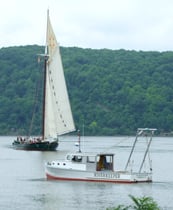Heads of Leading Environmental Organizations Outline Bold Vision for Quadricentennial Decade

View more images on our Flickr site
Hudson River Sloop Clearwater
Riverkeeper
Scenic Hudson
Contact: Tom Staudter, Clearwater, 845 454 7673, Ext. 112
Andrea Kott, Riverkeeper, 914 478 4501, Ext. 239
Jay Burgess, Scenic Hudson, 845 473 4440, Ext. 222
FOR IMMEDIATE RELEASE
June 10, 2009
Heads of Leading Environmental Organizations Outline Bold Vision for Quadricentennial Decade
HUDSON VALLEY – As the Quadricentennial Flotilla journeyed upriver, attracting unprecedented crowds to the Hudson River’s shores, leaders of Hudson River Sloop Clearwater, Riverkeeper and Scenic Hudson gathered at the river’s edge in Poughkeepsie to announce goals for the Hudson Valley in the coming decade. This shared vision for protecting the region’s natural resources and connecting more people to these irreplaceable treasures is intended to create a legacy that will outlast this year’s celebrations.
During the joint press announcement, the heads of the region’s most powerful and successful environmental organizations – Jeff Rumpf, executive director of Hudson River Sloop Clearwater; Alex Matthiessen, president of Riverkeeper; and Ned Sullivan, president of Scenic Hudson – proclaimed that now is the time to spur increased awareness of the Hudson River’s importance as a natural resource and a foundation for creating a sustainable economic future for the valley. The shared goals are vital to reaching this vision, and during their announcement the leaders cited the valley’s history of innovation and leadership, especially in protecting the environment.
Shared goals for a healthy, livable and prosperous valley
The valley’s residents, visitors, communities and businesses will benefit from:
1. a swimmable river where water quality is regularly tested and reported, allowing the public to safely recreate in a Hudson that is free of sewage from outdated stormwater and wastewater infrastructure;
2. a fishable river where Hudson Valley residents can once again eat local fish without health concerns and limited commercial fisheries can thrive;
3. completion of General Electric’s cleanup of toxic PCBs it dumped in the Hudson;
4. abundant, clean energy provided by modern, state-of-the-art power plants with updated pollution-control technology that doesn’t leave us with fouled air or a damaged river;
5. 65,000 acres of the most important scenic, ecological and agricultural significance along the Hudson forever protected, with riverfront parks where people can experience the river’s majesty and power to inspire;
6. a heritage trail on both sides of the river from Albany to New York City that affords walking, kayaking/canoeing and other recreational opportunities and ways to experience history in a region designated by Congress as a National Heritage Area;
7. the Hudson River estuary boasting vibrant land, water and wildlife, with protected land that will buffer the impacts of global climate change;
8. establishing the Hudson River as a great learning resource and creating a “pipeline” of new green leaders through support and advocacy for comprehensive environmental-education programs;
9. establishing effective diversity outreach and consistent dialogue efforts to all people along the river, focusing on environmental justice and staunch protection of our natural resources;
10. shifting our focus to creating a sustainable economy based on building eco-friendly green cities.
“The core to a sustainable future is creating the next generation of environmental leaders, starting with our youth and including all of the people of the Hudson Valley. Introducing more people to the new paradigm of green living while building new and retro-fitted green cities will help strengthen our economy and protect the environment for the future,” said Mr. Rumpf.
“The communities along the Hudson River have always played a leading role in shaping our nation – from winning the War of Independence to establishing the Adirondack Park to launching the modern environmental movement with the victory at Storm King Mountain. As we honor the Quadricentennial, we need to continue that tradition, setting visionary yet attainable goals that will make the Hudson Valley a model of sustainable living based on smart growth. Our organizations have led the fight to reclaim the Hudson, and working together we’ll achieve the goals we’ve set forth today,” said Alex Matthiessen, president of Riverkeeper.
“It’s only fitting that the region credited as the cradle of the modern environmental movement is home to three vigorous and collaborative groups setting their sights on accomplishing such lofty goals. Protecting the valley’s remaining must-save landscapes – forests that mitigate climate change impacts, farmland providing healthy local produce, as well as iconic views and recreation opportunities that inspire us – will create the green infrastructure that’s essential to our outstanding quality of life and future economic prosperity. Together we can leave a Quadricentennial legacy worthy of its own celebration 100 years from now,” said Mr. Sullivan.
A track record of working together
For four decades, Scenic Hudson, Riverkeeper and Hudson River Sloop Clearwater have worked together to protect the river and its shores while enhancing residents’ quality of life. In the early 1960s, Riverkeeper (then the Hudson River Fishermen’s Association) joined Scenic Hudson in the successful legal battle to halt a massive hydroelectric plant from defacing Storm King Mountain. Beginning in 1969, the sloop Clearwater aided the crusade by focusing public attention on threats to the river. All three organizations played important advocacy roles in passage of the federal Clean Air and Clean Water Acts. They also led the victorious 25-year fight to compel General Electric to cleanup 1.3 million pounds of toxic PCBs it dumped in the Hudson River for more than 30 years.
In the last decade, Scenic Hudson, Riverkeeper and Clearwater partnered with the Friends of Hudson coalition to defeat construction of the huge St. Lawrence Cement plant on the Greenport, Columbia County, riverfront. As members of the Friends of Kingston Waterfront coalition, Scenic Hudson and Clearwater are working to ensure that new development along the city’s shoreline provides public access to the river and does not destroy world-class views or important wildlife habitat. Action by Riverkeeper and Scenic Hudson led to the reopening of the Bethlehem Energy Center in Albany County utilizing clean fuel and 90 percent less river water for cooling. Under Riverkeeper’s leadership, all three organizations are continuing to work on compelling power plants along the river to comply with regulations requiring them to apply the most efficient cooling technologies.
Distinct, but interconnected, focus of each group
Hudson River Sloop Clearwater’s core mission is educating the next generation of environmental leaders. The organization was founded by folk singer and activist Pete Seeger over 40 years ago, and is set to make history again with its Next Generation Legacy Project, an ambitious educational initiative to create new leaders for tomorrow’s green world. Clearwater with its Next Generation Legacy Project is broadening its mission by bringing together school-age children and young adults from cities, suburbs and small towns to train and prepare them “to pick up the torch,” as Mr. Seeger would say, and create the sustainable world, with green jobs that we all need. Clearwater is developing a comprehensive educational program that focuses on many of the elements necessary for a green economy, including sustainable-energy technologies, best practices in organic farming and employment opportunities in new job sectors. The group continues connecting young people to the Hudson River and its watershed through innovative, hands-on learning.
Riverkeeper’s core mission is enforcing our environmental laws to ensure a healthy Hudson River. It has been the Hudson River’s leading watchdog and advocate for more than 40 years, working to protect the ecological integrity of the river, its tributaries and the watersheds that provide drinking water to 9 million residents of New York City and Westchester and Ulster counties. Riverkeeper is pursuing long-term solutions to the challenges facing the entire Hudson River estuary: the replacement and rebuilding of aging infrastructure to eliminate combined sewage overflows; the dredging of PCBs; declaring the Gowanus Canal and Newtown Creek as Superfund sites; the reduction of power plant and development impacts on river ecology and wildlife. At the same time, Riverkeeper is testing water quality for the entire span of the river, from New York Harbor to Troy, and posting the results on its Web site, because it believes every New Yorker has the right to clean water and access to water quality information.
Scenic Hudson’s core mission is preserving land and creating parks that connect people with the Hudson River. The group works to protect and restore the Hudson River and its majestic landscape as an irreplaceable national treasure and a vital resource for residents and visitors. A crusader for the valley since 1963, the group is credited with saving fabled Storm King Mountain from a destructive industrial project and launching the modern grass-roots environmental movement. Today with more than 25,000 ardent supporters, it has a team of experts who combine land acquisition, support for agriculture, citizen-based advocacy and sophisticated planning tools to create environmentally and economically healthy communities, open up riverfronts to the public and preserve the valley’s inspiring beauty and natural resources. Having already created or enhanced 40 public parks, Scenic Hudson’s top priority is its campaign to Save the Land That Matters Most, launched in 2007 to provide a lasting commemoration of the Quadricentennial. It is a multi-year, collaborative effort with fellow land trusts, governments, individuals and businesses to protect 65,000 acres of the greatest scenic, ecological and agricultural significance throughout the Hudson Valley.

